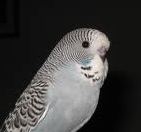
If you are breeding your budgie for color, it is essential you do everything possible to give your budgies high quality coats and good color.
Base Colors
All budgies have a certain base color, which is then sometimes affected by color mutations. In the wild, budgies are usually green. Green birds are known as yellow-base birds, meaning their genes contain a yellow pigment base. Green budgies may come in shades of olive, bright green, and nearly any other shade or patterning you can think of. The second most common type of budgie is the blue budgie, which is known as white-base. Again, mutations can result in a bright blue bird, a diluted blue, a violet tone, a gray and many other colors.
Color Factors
Different color factors affect the base coloring and patterning of the budgies. Each factor reacts differently with the base color. For example, the dark factor adds depth of color or dark highlights, while the dilution factor washes out the color of the bird. A green bird with two genetic dark factors will usually be olive green. A blue, white-base, bird with a dilution factor will appear to be a very light or grayish blue. Other color mutation factors include gray factor, yellowface, black face, slate, violet factor, saddle back and clear wing. Each factor affects a different color scheme or patterning on the bird, and may affect only a certain part of the bird. Lutino and albino are other common color factor mutations. A lutino bird is essentially a yellow-base bird with no other colors, which appear totally yellow. An albino budgie is a white-base bird with no other colors, and therefore appears totally white.
Pied Budgies
Pied budgies are essentially birds with splashes of clear feathers, or spots of color different from their body color. There are several different types of pied genes which can affect how much or little coloring and clear feathering the bird has. These factors include recessive and dominant pied genes, dark-eyed clear pied birds and clear flight pied birds. Like other color mutations, the pied genes may show up in conjunction with other color or pattern mutations, which can create many fantastic and unusual feather colors and patterns.
Striping Factors
Many budgies display or have the genes for striping on their wings and heads. Striping factors are mutations which affect the appearance of these stripes. The three main striping factors are cinnamon, opaline and spangle. Cinnamon turns stripes that are usually black a brown color. Opaline creates thicker white stripes and thinner black stripes on the head. Spangle creates the same effect as opaline, except it's on the wings and tail.

Post a Comment